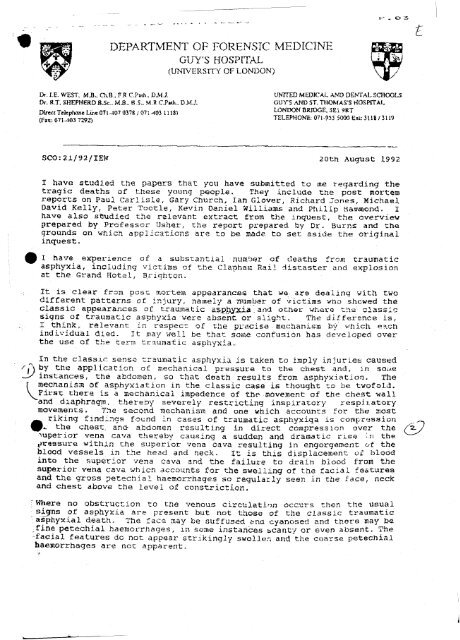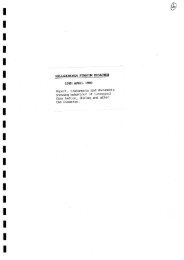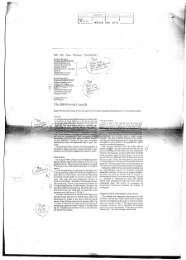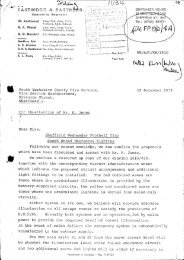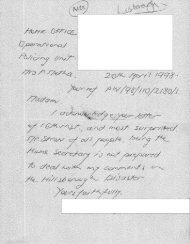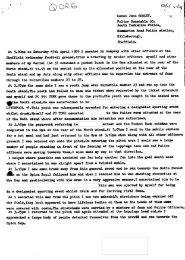DEPARTMENT OF FORENSIC MEDICINE - Hillsborough ...
DEPARTMENT OF FORENSIC MEDICINE - Hillsborough ...
DEPARTMENT OF FORENSIC MEDICINE - Hillsborough ...
You also want an ePaper? Increase the reach of your titles
YUMPU automatically turns print PDFs into web optimized ePapers that Google loves.
<strong>DEPARTMENT</strong> <strong>OF</strong> <strong>FORENSIC</strong> <strong>MEDICINE</strong><br />
GUY'S HOSPITAL<br />
(UNIVERSITY <strong>OF</strong> LONDON)<br />
Dr. I.E. WEST. M.B.. CTxB.. F R C.I'ith.. D M J.<br />
Dr, R T. SHEPHERD B.Sc.. M £.. B S.. M R C.P«h.. D M.i.<br />
Direct Tekphanc Line 071 -107 0378 j 071 -403 11 IS)<br />
(F*x: 071-403 7292)<br />
UNITED MEDICAL AND DENTAL SCHOOLS<br />
GUY’S AND ST. THOMAS'S HOSPITAL<br />
LONDON BRIDGE. SEl 9RT<br />
TELEPHONE: 071-955 5000 Ext: 3118/3119<br />
SCO:21/92/IEW 20th August 1992<br />
I have studied the papers that you have submitted to me regarding the<br />
tragic deaths of these young people. They include the post mortem<br />
reports on Paul Carlisle, Gary Church, Ian Glover, Richard Jones, Michael<br />
David Kelly, Peter Tootle, Kevin Daniel Williams and Philip Hammond. I<br />
have also studied the relevant extract from the inquest, the overview<br />
prepared by Professor Usher, the report prepared by Dr. Burns and the<br />
grounds on which applications are to be made to set aside the original<br />
inquest.<br />
I have experience of a substantial number of deaths from traumatic<br />
asphyxia, including victims of the claphaK Rail distaster and explosion<br />
at the Grand Hotel, Brighton.<br />
It is clear from post mortem appearances that we. are dealing with two<br />
different patterns of injury, namely a number of victims who shewed the<br />
classic appearances of traumatic aspjhyxia. and other where ths’ classic<br />
signs of traumatic asphyxia were absent or slight. The difference is,<br />
I think, relevant in respect of the precise.mechanism by vhich ench<br />
individual died. It may v/eli be that soiae confusion has developed over<br />
the use of the terra traumatic asphyxia..<br />
In the classic sense traumatic asphyxia is taken to imply injuries caused<br />
^ A by the application of mechanical pressure to the chest and, in sowe<br />
.— ' instances, the abdomen, so that death results from asphyxiation- The<br />
f mechanism of asphyxiation in the classic case is thought to be twofold.<br />
V^First there is a mechanical impedence of the movement of the chest wall<br />
and diaphragm, thereby severely restricting inspiratory respix.at.ory<br />
movements. The second mechanism and one which accounts for the most<br />
rising findings found in cases of traumatic asphyxiqa is cotnpr^ssion<br />
fP*. the chest, and: abdomen resulting in direct compression over the<br />
superior vena cava thereby causing a sudden and dramatic rise \v. the<br />
treasure within the superior vena cava resulting in engorgement o f the<br />
blood vessels in the head and neck. it is this displacement, of blood<br />
into the superior vena cava and the failure to drain blood from the<br />
superior vena cava which accounts for the swelling of the facial features<br />
and the gross petechial haemorrhages so regularly seen in the face, neck<br />
and chest above the level of constriction.<br />
[Where no obstruction to the venous circulation occurs then the usual<br />
s:y?ns asphyxia are present but not those of the classic traumatic<br />
asphyxia1 death. The face may be suffused &na cyanosed and there may be<br />
fine petechial haemorrhages, m some instances scanty or even absent. The<br />
-facial features do not appear strikingly sw o llen and the coarse petechial<br />
haemorrhages are not apparent.
. w<br />
£ WED 0 -3 S 2 1 WHITFIELDS<br />
<strong>DEPARTMENT</strong> <strong>OF</strong> <strong>FORENSIC</strong> <strong>MEDICINE</strong><br />
GUY’S HOSPITAL<br />
(UNIVERSITY <strong>OF</strong> LONDON)<br />
O, i e . WEST. M.B., CUJB.. F.R.C.Pith., D.MJ.<br />
Dr- R.T. SHEPHERD B-Sc,. M-8.. B.S_ MR.C.P«h.. D M X<br />
D if act Telephone tine 07M 0? 037g /0 7 l-i0 3 1118)<br />
(F«: 071-103 7292)<br />
UNITED MEDICAL AND DENTAL SCHOOl-S<br />
GUTS AND ST. THOMAS'S HOSPITAL<br />
LONDON BRIDGE. SEl 9RT<br />
TELEPHONE. 011-955 5000 Ext: 3118/3119<br />
Unfortunately it has become a habit for pathologists to call all such<br />
deaths traumatic asphyxia and it may well be correct in one sense in as<br />
much as trauma to the chest has resulted in the mechanical obstruction<br />
of respiration- In pathological terms there is probably little relevance<br />
in distinguishing between the two mechanisms as the term merely implies<br />
that death has resulted from a mechanical obstruction to respiration<br />
resulting from pressure being applied to the torso.<br />
In clinical terms however there does seem to be a difference in the two<br />
different types of traumatic asphyxia with a much graver prognosis being<br />
•<br />
present in those where there has been evidence of a sudden and acute<br />
severe rise in the venous pressure in the upper part of the body. In fact<br />
most of the individuals who suffer from this classic form of traumatic<br />
asphyxia do not survive if they are severely affected and not rescued<br />
rapidly.<br />
R . G> -•»<br />
where the individual suffers primarily an obstruction to his movements<br />
of respiration death will occur as the result of hypoxic damage to the<br />
brain. This may take a much longer time than in individuals who have J,<br />
}?een crushed so impedence of the venous return to the heart occurred, yi<br />
Indeed some individuals will survive but remain permanently r<br />
neurologically damaged as a result of suffering severe anoxic cerebral<br />
injury.<br />
It is probable that a period of at least some 10 minutes or so would be<br />
necessary before one would be able to state categorically that absent .#<br />
respiratory movement would lead to death- Consciousness may be lost quite LJ<br />
rapidly but where the obstruction has not been complete consciousness may /»<br />
take a considerable time to be lost. I have experience of cases where<br />
individuals have died through anaesthetic accidents whereby no oxygen was<br />
zin g supplied to the lungs whilst they were paralysed during surgery,<br />
two of the cases in e x c e s s of 10 minutes elapsed before the surgeon<br />
noticed that the heart action was in the terminal stages of failure.<br />
It is also known that individuals who have suffered severe hypcxic damage<br />
may not die immediately. They may be recovered unconscious with an<br />
active circulation but the circulation rapidly fails despite all attempts<br />
at x’esuscitation. This roav well represent concomitant damage to the heart<br />
muscle leading to what is in effect a heart attack (anoxic myocardial<br />
infarction). severe hypoxia of several minutes duration would be<br />
necessary for this tc occur- It is therefore possible that a young man<br />
who had been asphyxiated by being crushed, would be capable, after being<br />
removed from danger, of some conscious activity but could still die as<br />
a result of hypoxia in the ensuing minutes.
w e ^ r - i ± I f- 1 bL JUS<br />
<strong>DEPARTMENT</strong> <strong>OF</strong> <strong>FORENSIC</strong> <strong>MEDICINE</strong><br />
GUY’S HOSPITAL<br />
(UNIVERSITY <strong>OF</strong> LONDON)<br />
Dr. I.E. WEST, MJB-. OuB.. F R.C.Path.. DJvlJ.<br />
Dr. R.T, SHEPHERD B.Sc.. MJ9-. B-S., M.R.Ci>»ih, D.MJ.<br />
Direct Telephone Law 071 -107 0378 / 071 -403 1118)<br />
(Fax; 071-403 7292)<br />
R - © 5<br />
UNITED MEDICAL AND DENTAL SCHOOLS<br />
GUYS AND ST. THOMAS'S HOSPITAL<br />
LONDON BRIDGE. SE3 9RT<br />
TELEPHONE; 07t-$55 5000 E*t 3113/311?<br />
Anoxic brain damage could also be aggravated by the failure to maintain<br />
a patent airway in individuals who were unconscious but still capable of<br />
respiration when retrieved from the crowd. The failure to place the<br />
individual in the recovery position, for instance, could lead to<br />
subsequent ’respiratory obstruction.<br />
Experience from a number of instances where individuals have died from<br />
traumatic asphyxia has also demonstrated that not all individuals appear<br />
to have been effected at the same time. Some could have been effected by<br />
movement of the crowd in the minutes after the disaster occurred, others<br />
could have had only partial or incomplete respiratory obstruction<br />
initially and then either suffered complete mechanical obstruction of<br />
respiration or died as the result of prolonged incomplete respiratory<br />
obstruction. This could take many minutes to cause death and it is<br />
entirely possible that death would occur more than 15 minutes after the<br />
incident began-<br />
I have not seen the post mortem photographs and therefore am having to<br />
rely solely on the description provided in the post mortem reports: I<br />
will deal with each case individually.<br />
1. Paul Carlisle - He was examined by Professor Usher who describes<br />
suffusion of the upper body and petechial haemorrhages on the<br />
forehead, eyelids and within the conjunctivae. These would be<br />
consistent with the classic traumatic asphyxia whereby there has<br />
been a mechanical obstruction and mechanical interference with the.<br />
circulation.<br />
2- Richard Jones - He was examined by Professor usher w h o again found<br />
signs which would be consistent with the classic features o f<br />
traumatic asphyxia. The petechial h a e m o r r h a g e s noted in his loins<br />
are probably the result of pressure causing local obstruction to the<br />
circulation m that area.<br />
3 . Ian Glover - Again examined b y Professor Usher. The examination<br />
revealed changes of asphyxia/ ie the c y a n o s i s and visceral<br />
haemorrhages. The signs of venous obstruction were relatively<br />
slight and in the form of small petechial haemorrhages in the upper<br />
eyelids and conjunctiva of the left eye. There were scanty<br />
petechiae also found in the larynx. in ray opinion he has died<br />
primarily as the result of impedence of respiration and any<br />
interference with his venous circulation was minimal.<br />
4. Peter Tootle - Was examined by Dr. Slater- Dr. Slater described<br />
changes in Mr. Tootle which are consistent with a degree of classic<br />
traumatic asphyxia but I suspect that the main reason for death has<br />
been compression of the chest resulting in impudence of respiratory
<strong>DEPARTMENT</strong> <strong>OF</strong> <strong>FORENSIC</strong> <strong>MEDICINE</strong><br />
GUY’S HOSPITAL<br />
(UNIVERSITY <strong>OF</strong> LONDON)<br />
Dr. I.E. WEST, M-B.. OvB.. FR.C.PaUi.. D.MJ.<br />
Dr. R.T. SHEPHERD B.Sc., MJ8.. B.S.. M.R.C.Pa(h.. D.MJ.<br />
Direct Telephone Lme 071 -107 0378 / 071 -,103 1118)<br />
(fix: 071 -103 7292)<br />
UNITED MEDICAL ANT) DENTAL SCHOOLS<br />
GUYS AND ST. THOMAS S HOSPITAL,<br />
LONDON BRIDGE. SE1 9RT<br />
TELEPHONE: 071-955 5000 Ext: 3118/3119<br />
movement. Without the post mortem photographs I am not clear as to<br />
why Dr. Slater feels that there has been intensive blunt compression<br />
of the right side of his face.<br />
5. Kevin Williams - Was examined by Dr. Slater who describes the<br />
external features of classic traumatic asphyxia with cyanosis of the<br />
face extending onto the chest with numerous petechial and larger<br />
haemorrhages on the face and neck. He found bilateral fractures of<br />
the hyoid bone and of the superior horns of the thyroid cartilage<br />
on both sides of the larynx. These appear related to a number of<br />
linear abrasions over the front of his neck and on the undersurfac®<br />
of the chin. There appears to have been local pressure to his neck.<br />
It was possible that when he was crushed in the crowd, the front of<br />
his neck, vas pushed against some rigid structure. It is also<br />
possible that, for instance, he could have been trodden an during<br />
the panic subsequent to the incident occurring.<br />
P . 0 6<br />
*1 do not believe it is possible to say how long consciousness would<br />
" have been retained but he^ certainly would noc have become<br />
unconscious between 3 and 5 seconds of being crushed. Again I would j<br />
not agree with Dr. Slater in estimating how long the deceased would yj<br />
have survived. Although he-has suffered injuiies to the neck these<br />
are by no means invariably fatal and can be seen in those surviving<br />
strangulation and quite striking signs of classic traumatic asphyxia<br />
can be seen in individuals who survive crush incidents because they j/<<br />
are removed frow danger in tiiae to prevent death- As I have already VIJI<br />
indicated he could veil have survived for a considerable period,/tI<br />
well beyond 3.15 pm.<br />
He suffered convulsions as the result of anoxic brain damage.<br />
Whether Mr. Brooder saw convulsions or twitching is irrelevant.<br />
A dead body neither convulses or twitches. Dr. Gompert’s point that<br />
bodies may twitch after brain stem death has taken place is, of<br />
course, correct and to some degree reflects the dilemma over<br />
precisely defining death. One sees it in individuals who are<br />
maintained on a respirator but whose heart is still functioning.<br />
One also may see it during the process of dying as the heart is<br />
stopping and for a very short period after the heart stops. This<br />
phenomenon only occurs for a very short, period after death unless<br />
muscles are electrically stimulated. Twitching movements, however,<br />
suggest that one is much inore likely to be dealing with a live body<br />
than with a dead one.<br />
The evidence of Special Constable Martin is difficult to refute in<br />
some respects. Whilst it is possible for an individual examining a<br />
dead body to mistakenly feel an apparent pulse it is usually<br />
difficult to be mistaken over whether somebody is making breathing
<strong>DEPARTMENT</strong> <strong>OF</strong> <strong>FORENSIC</strong> <strong>MEDICINE</strong><br />
GUY’S HOSPITAL<br />
(UNIVERSITY <strong>OF</strong> LONDON)<br />
Dr-f-S-WEST. M.B.. Ch.B.. F.R.C.Paih_ D.MJ.<br />
Df. R.T. SHEPHERD B.-Sc. M J , B.S., M.R.C.PsiK D.MJ.<br />
Dircct Telephone Lm c07U 07 0378 / 071-) 03 1118)<br />
(Fax: 071-403 7292)<br />
UNITED MEDICAL AND DENTAL SCHOOLS<br />
C V YS AND ST. THOMAS'S HOSPITAL<br />
LONDON BRIDGE. SEl 9RT<br />
TELEPHONE: 071-955 5000 Ext: 3U 8 /3119<br />
^ movemen,t!S,J3jt-aQJ5!.- I am, of course, making the assumption here that<br />
^ when the term breathing is used that we are referring to movements<br />
of respiration and not merely sounds. Sounds frequently emanate<br />
from the air passages of a recently dead body when it is being<br />
moved. v<br />
S<br />
6. Gary Church - He was examined by Dr. Slater who found changes<br />
which would be consistent with classic traumatic asphyxia. He had<br />
a dislocated right sternoclavicular joint. T h i s type of injury is<br />
H most likely to occur as the result of falling. It would require<br />
very severe crush injuries to dislocate the sternoclavicular joint<br />
and the post mortem findings do not appear to reflect severe local<br />
pressure on the chest or shoulder area. It is possible that he<br />
received this injury as the result of falling over in an attempt to<br />
escape and has suffered pain and discomfort consequent upon this<br />
injury.<br />
7. Michael David Kelly - He was examined by Dr. John Clark who found<br />
non specific signs of asphyxia; the external appearances do not shew<br />
evidence of classic traumatic asphyxia. The petechial haemorrhages<br />
on his right arm I am sure reflect a obstruction to the circulation<br />
in the ara caused by local pressure. The internal examination<br />
revealed no other explanation for death other than it. having<br />
resulted from anoxia and it is probable here that we are dealing<br />
with a case where there is no evidence whatsoever of obstruction to<br />
the large veins in the body tut where death has occurred as the<br />
result cf progressive cerebral anoxia resulting from prolonged and<br />
severe compression of the chest.<br />
If Mr Kelly was treated as described by PC Mauahan and apparently<br />
successfully resuscitated then it is possible that he has died as<br />
the result of hypoxic damage affecting his heart or as the result<br />
of seme other forTi o f respiratory obstruction. He appears not to<br />
have been placed in the recovery position and this may well be<br />
material. There is nothing to indicate that this man was definitely<br />
dead by 2,i5pn; indeed the evidence available to me suggests<br />
otherwise.<br />
8. Philip Hammond - this young boy does not bear the classic signs<br />
of tramnatic asphyxia although there are generalised asphyxial signs<br />
and evidence of anoxic damage to che brain. Dr. Slater who<br />
performed the post raortem found extensive haemorrhage in both lungs<br />
and a laceration of the right lung associated with a fracture of the<br />
right 2nd rib. 1 think the death of this young man is rather more<br />
complicated than some of the other cases. There is certainly<br />
evidence that he has suffered from asphyxia and there is evidence<br />
in his brain of anoxic damage. However, the primary pathology<br />
R - © T
' W '<br />
»■« i i i. i r jl tz. I— -A-*<br />
<strong>DEPARTMENT</strong> <strong>OF</strong> <strong>FORENSIC</strong> <strong>MEDICINE</strong><br />
GUY'S HOSPITAL<br />
(UNIVERSITY <strong>OF</strong> LONDON)<br />
Dr. I.E. -WEST. MB.. FR.C.Pwix.. D.M.J.<br />
Dr. R.T. SHEPHERD B.Sc., M 3., J3.S, M-R.C.Piih-. D.M.J.<br />
Direct Telephone Line 071-107 03?g /071-103 1118)<br />
(Fa*: 071-J03 7292)<br />
P - 0 8<br />
UNITED MEDICAL AND DENTAL SCHOOL<br />
GUYS AND ST, THOMAS'S HOSPITAL<br />
LONDON BRIDGE, SE1 9RT<br />
TELEPHONE: 071 -955 5000 Ext: 3118 / 3119<br />
appears to be in his lungs which were bruised with a laceration of<br />
the right lung associated with a rib injury. The rib injury and<br />
bruising of the adjacent intercostal spaces suggests a localised<br />
pressure or impact, in that region of the right chest. It is likely<br />
to have Been due to localised pressure, probably on the young man’s<br />
back, forcing the right side of his chest against an object causing<br />
the right s i d e d ribs to be forced inwards towards the spine. If<br />
this pressure were maintained then death would undoubtedly occur<br />
very rapidly but I would have expected to have found sorae-evidence<br />
^ of the more classic changes associated with traumatic asphyxia. If,<br />
however, the pressure is relieved then death from injuries of this<br />
type may take considerable time to supervene. Unconsciousness is<br />
likely to be fairly rapid but death could have taken a substantial<br />
number of minutes and it would be impossible, from a medical point<br />
of view, to state that this boy was dead at 3,15 pm.<br />
In conclusion there is clear evidence that some of the victims have<br />
suffered severe traumatic asphyxia in the classic sense in which the term<br />
• is employed'. Jnconscious:iess is liKely to have occurred quite rapidly,<br />
in probably somewhere between 15 and 45 seconds but dearh would have been<br />
delayed for a number cf minutes. In those who where severely crushed so<br />
the venous drainage from the head was impeded then it is probable that<br />
death would have occurred within 10 minutes of sustained pressure<br />
commencing. if the pressure was not continuous survival could be for<br />
a longer period.<br />
In the individuals who have scanty signs or no signs of traumatic<br />
asphyxia it is much more difficult to predict the survival time. To<br />
re|l’ce the survival time to a very short number of minutes would require<br />
cf^Linuous sustained severe compression of the chest. Because of the<br />
r ure of the incident it is impossible in many instance to know when<br />
mechanical compression of the chest would have commenced. I feel it is<br />
impossible to state purely from the medical point of view that a number<br />
of the young men that I have indicated above could not been alive at 3.15<br />
pm. Those dying as the result of anoxic damage consequent to their chests<br />
being crushed could well have survived for a much longer period only to<br />
die subsequently from the effects of irreversible anoxia.<br />
[ain Eric West, M.B., cn.B F. R. CTPath., D.M.J<br />
Consultant Forensic Pathologist,<br />
iirector, Department of Forensic Medicine,<br />
’nited Medical Schools of Guy's and St. Thomas',<br />
uy's Hospital,<br />
ondon, SEl 9RT.
<strong>DEPARTMENT</strong> <strong>OF</strong> <strong>FORENSIC</strong> <strong>MEDICINE</strong><br />
GUY'S HOSPITAL<br />
Dr I.E. WEST, MJ3..ChJB., D.M J.<br />
Dr. R.T. SHEPHERD B.Sc.. MJ3„ B.S„ M.R.C.Path.. D.M.J.<br />
Direct Telephone Line 071 -407 0378<br />
(Fix: 071-403 7292)<br />
(UNIVERSITY <strong>OF</strong> LONDON)<br />
UNI FED MEDICAL AND DENTAL SCHOOLS<br />
GUTS AND ST. THOMAS'S HOSPITAL<br />
LONDON BRIDGE. SEI 9RT<br />
TELEPHONE: 071 -955 5000 Ext: 311S / 3119<br />
SCO:21/92/IEW 29th October 1993<br />
I have studied the photographs of Kevin Williams, Michael Kelly, Peter<br />
Tootle, Ian Glover, Richard Jones and Paul Carlisle. I have reviewed the<br />
photographs together with the original post mortem reports.<br />
All photographs are identified on the album covers and there are marks<br />
of identification on all of the bodies. Names were inscribed upon the<br />
right lower limbs.<br />
The photographs of Paul Carlisle confirm that he has died as a result of<br />
classic traumatic asphyxia. There are also some abrasions on the forehead<br />
and chin consistent with being crushed in the incident.<br />
The photographs of Richard Jones confirm the classic signs of tr a u m a tic<br />
asphyxia in the head and neck with evidence of constriction around the<br />
chest. They also confirm the presence of inhaled vomit in the airway.<br />
The photographs of Ian Glover reveal more minor changes of asphyxia with<br />
cyanosis of the face but no overt swelling. There were abrasions visible<br />
on the undersurface of the chin and on the left ankle.<br />
From Professor Usher's report it was clear that vomit was present in the<br />
deceased's air passages. inhalation of vomit may occur during life in<br />
a number of circumstances including compression^ of the chest and/or<br />
abdomen. Traces, of vomit may also enter the airway as a result of<br />
passive regurgitation after death, either as the result of attempts at<br />
resuscitation or when the body is being moved.<br />
The photographs of Peter Tootle are not particularly helpful^ in that<br />
there is no close view of his face, The photographs reveal abrasions over<br />
the lumbar region- of the back and over the upper chest region adjacent<br />
to the spine. The facial features, as reviewed in the full length<br />
photograph, do not suggest the classic features of traumatic asphyxia,<br />
nor can I see any evidence of substantial blunt trauma to the face.<br />
I have seen photographs which, on the cover the album are labelled<br />
Miohael Kelly, but the indication on the leg of the deceased is Kelly -<br />
A.P. with the number 17841. The photographs do not appear to be those<br />
of the deceased described by Dr. Clark in his post mortem report. The<br />
photographs of the deceased show a man, 167cm in height, showing moderate<br />
truncal obesity with heavy tattooing on both arms. The deceased in this<br />
case also showed signs of severe traumatic asphyxia. I do not believe<br />
that I have seen the correct photographs in this case.
FuF.El fSI I MEDIC il'to uu< -■<br />
<strong>DEPARTMENT</strong> <strong>OF</strong> <strong>FORENSIC</strong> <strong>MEDICINE</strong><br />
GUY’S HOSPITAL<br />
(UNIVERSITY <strong>OF</strong> LONDON)<br />
WEST, MJB., Ch.B„ F.R.C.P*th„ DW J.<br />
T. SHEPHERD B.Sc., MJ3., B.S., M.R.C.P*th„ DMJ.<br />
. Telephone Line 071-407 0378<br />
071-403 7292)<br />
UNITED MEDICAL AND DENTAL SCHOOLS<br />
GUVS AND ST. THOMAS'S HOSPITAL<br />
LONDON BRIDGE. SE1 9RT<br />
TELEPHONE: 071-955 5000 Exi: 3118/3119<br />
e photographs of Kevin Williams appear to show the correct body. They<br />
.nat.indicate the classic signs of traumatic asphyxia. There^i^no<br />
eliing of the face although there js'll5ae1 cyanosis. The most prominent,<br />
.ndings that can be seen on the photographs are the injuries _ o v e r the<br />
idersurface of the chin and left jawline just below the prominence^of<br />
le larynx (Adam’s apple). The photographs indicate one long a b r a s i o n<br />
ider the right side of the chin and an abrasion under the left jawline<br />
.id two abrasions over the region of the larynx. An additional abrasion<br />
s visible just outside the left eye. There,also appears to be deformity<br />
f ^ ) neck in the region of the larynx.<br />
n / opinion there has been substantial damage to the front of Mr.<br />
illiams neck as the result of compression of the neck possibly caused<br />
>y his neck being crushed under the feet of individuals in the crowd or<br />
I caused by his neck being crushed against some rigid object. The<br />
Jeformity seen in the photographs and the fractures, found by Dr. Slater<br />
I luring his post mortem examination, strongly suggest that damage to the<br />
apper airway was an important contributory factor in the death of Kevin<br />
Williams. Damage to the airway at this level may lead to obstruction and<br />
swelling of the lining of the larynx which reduces the amount of air that<br />
can reach the deceased's lungs. As I have stated in my previous report<br />
I do not believe that this type of injury would lead to.unconsciousness<br />
within a few seconds. Whilst death may occur repdily following such<br />
laryngeal injuries this is not inevitably the case and death may be<br />
delayed for a considerable period. This type of injury is amenable to<br />
treatment in the form of an emergency tracheostomy or a cricothyroidotomy.<br />
Whilst an emergency tracheostomy is a relatively major<br />
p ^ f e d u r e , crico-thyroidotoray is a simpler procedure which involves the<br />
pBLage of a tube through the membrane between the thyroid and cricoid<br />
c tilages. It is possible that if one of these procedures had been<br />
carried out at the scene then he would not have suffered from the fatal<br />
asphyxia which led to his death.<br />
Both cricothyroidotoray and emergency tracheotomy can be performed in the<br />
field although, in the latter instance# with difficulties owing to an<br />
increased likelihood of haemorrahge at the operation site.<br />
I could find nothing, from the post • mortem report or from the<br />
photographs, to refute the realistic possibility that this young man was<br />
,still alive after 3.15 pm on the day. I do accept, however, that he is<br />
/unlikely to have spoken the word "Muiti" if he had already suffeced<br />
convulsions due to lack of oxygen. In my opinion, the primary cause of<br />
death in this instance is damage to his neck which would not have been<br />
inevitably rapidly fatal.
y -r——<br />
FOPEH'r' 1 ■; MEDIC IKE GUT'E O'71 -*03 729-' P.p<br />
<strong>DEPARTMENT</strong> <strong>OF</strong> <strong>FORENSIC</strong> <strong>MEDICINE</strong><br />
GUY’S HOSPITAL<br />
(UNTVERsrry o f l o n d o n )<br />
x. l.Ei WEST,<br />
X. R.T. SHEPHERD B.Scn M 3 , B.S„ M.R.C-P*ih., J3.M J .<br />
)irect Telephone Line 071*407 0378<br />
F « : 071-403 T292)<br />
UNITED MEDICAL AND DENTAL SCHOOLS<br />
GUTS AND ST. THOMAS’S HOSPITAL<br />
LONDON BRIDGE. SEl 9RT<br />
TELEPHONE: 071 -955 5000 E xt 3118 / 3119<br />
In relation to the individuals who have died of traumatic asphyxia.; it<br />
is possible to say that, with sustained^ compression of the trunk# death<br />
could have occurred prior to 3.15 pm and that they were likely to have<br />
been quite rapidly rendered unconscious. There is no way, however, that<br />
one can state with any certainty that death occurred within that period.<br />
If the compression of the chest had been intermittent they could well<br />
have survived well beyond 3«15 pm.<br />
Iain Eric West, M.B., Ch.B., F.R.C.Path., D.M.J.,<br />
Consultant Forensic Pathologist,<br />
Director, Department of Forensic Medicine,<br />
United Medical Schools of Guy's and St. Thomas',<br />
Guy's Hospital,<br />
London, SEl 9RT.<br />
T Y


